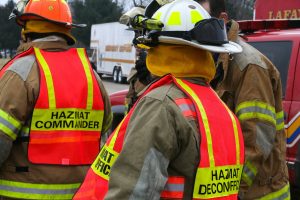The Teutopolis Tanker Crash Shows Us Why Spills Are Deadly
 It’s common knowledge, we think, that truck accidents can have devastating effects. It’s also common knowledge that there’s a lot of hazardous cargo being shipped around the country. The East Palestine train derailment really highlighted that.
It’s common knowledge, we think, that truck accidents can have devastating effects. It’s also common knowledge that there’s a lot of hazardous cargo being shipped around the country. The East Palestine train derailment really highlighted that.
But Friday’s tanker crash on US 40 in Teutopolis has brought that lesson home to Illinois, and everything about the situation is tragic. Sunday night, Effingham County Coroner Kim Rhodes released the names of the five victims of the spill; two of them were children. Seven more people went to hospitals (five by medevac) though we do not know if they remain there.
What exactly happened that led to the HAZMAT spill in Teutopolis?
This is a complicated scenario. Based on the latest news, a tanker carrying approximately 7,500 gallons of anhydrous ammonia was traveling on Highway 40; per CNN, it may have been rerouted because of a crash on I-70 earlier that day. From what the news reports indicate, another vehicle tried to pass the tanker. The tanker driver “appears to have reacted by pulling to the right,” and ended up departing the roadway. (Based on the different reports, the truck may or may not have jackknifed while doing so.) What we know for sure is that the truck rolled over, and when it did, it hit a hitch on a utility truck. That hitch punctured the tank, and that puncture released about 4,000 gallons of the gas into the air.
Why the punctured tanker posed a life-threatening risk to everyone
So now we’re dealing with a truck rollover and a HAZMAT spill. Anhydrous ammonia remains in liquid form until exposed to the atmosphere, where “it becomes a toxic gas. Liquid anhydrous ammonia expands 850 times when released to ambient air and can form large vapor clouds. It may aerosolize and behave as a dense gas, even though it is normally lighter than air.” In other words, the liquid turns into a gas, rapidly expands, and then just sits there, rather than dissipating into the air.
This is why there were mandatory evacuations, and why there were emergency services people out on the road, attempting to patch that hole. According to ABC 7 News, the emergency crews had to fight shifting winds in order to secure the area. Residents had to evacuate immediately, and NBC News reports there were abandoned vehicles on the roads.
About the dangers of exposure to anhydrous ammonia
Ultimately, the release of this gas appears to be the cause of five fatalities; CNN reports that the preliminary cause of death for all five people was exposure to ammonia. The National Institute for Occupational Safety & Health (NIOSH), which is part of the Centers for Disease Control and Prevention (CDC), says that “effects occur rapidly following exposure to ammonia. Some respiratory symptoms may be delayed in onset.” It is a corrosive irritant – and a serious one at that. In some cases, it can cause blindness, cataracts, glaucoma, chronic lung diseases, hemorrhage/rupture/scarring/narrowing of the digestive tract. It can burn anything it comes into contact with because it “binds” with water, including the water in your body. It can cause your throat to swell and restrict your ability to breathe.
What happens now?
It’ll take about a month for the National Transportation Safety Board (NTSB) to create its preliminary report, ABC 7 says, but it can take up to two years to officially “wrap up” the investigation.
We assume the NTSB investigation will seek to find out whether the accident could have been avoided. But if we’re honest, we’re a bit impatient. We have a lot of questions we’d like answers to:
- Why was a tanker carrying deadly HAZMAT material on US 40 in the first place? Per NBC News, that amount of ammonia would normally be “transported in smaller quantities by ‘nurse tanks’” to where it needs to go. Why so much in one tanker?
- Where was that tanker headed? Ammonia has a lot of agricultural uses, so we assume it was going someplace local.
- Who hired the trucking company to transport the ammonia? NBC News says the company is local and has a “satisfactory” rating; do they have a history of crashes? Are their drivers safe? How experienced was the driver?
- How fast was the tanker going? Nurse trucks only travel about 30mph, but tankers can travel more quickly. Was the driver speeding?
- What role did the other vehicle play, if any, in the reason why that tanker drove off the road and rolled over?
- Why was the tank able to be punctured? Shouldn’t the material be reinforced enough to avoid these types of incidents? What about the brakes and tires; were they safe?
- Where were all five victims, exactly? One report says that the tanker crash occurred “in the block of 19700 East Highway 40 on the east side of Teutopolis.” That’s all farmland out there, so how far away were the victims? Were they outside in the grass? In other cars? In their homes? We’d like to know how quickly that gas plume covered the area.
So now we wait. And if you’re the type of person who prays, you pray – because there are still seven other people who were hospitalized over this spill, and several others who sought treatment. Based on the last names of the victims, there are three families who lost loved ones; one of those families lost an adult and two children. There is so much grief and fear, so now is the time to be as supportive as we can, in any way that we can, because answers will be a long time coming.
Gainsberg Injury and Accident Lawyers exclusively represents injury victims in and around the greater Chicago area. To learn more about our services, please call us or fill out our contact form.

Attorney Neal Gainsberg has spent the last 20+ years fighting to protect the rights of the injured in Chicago and throughout Illinois. For dedicated legal help with a personal injury, car accident, or wrongful death matter, contact Gainsberg Injury and Accident Lawyers in Chicago for a free consultation.
